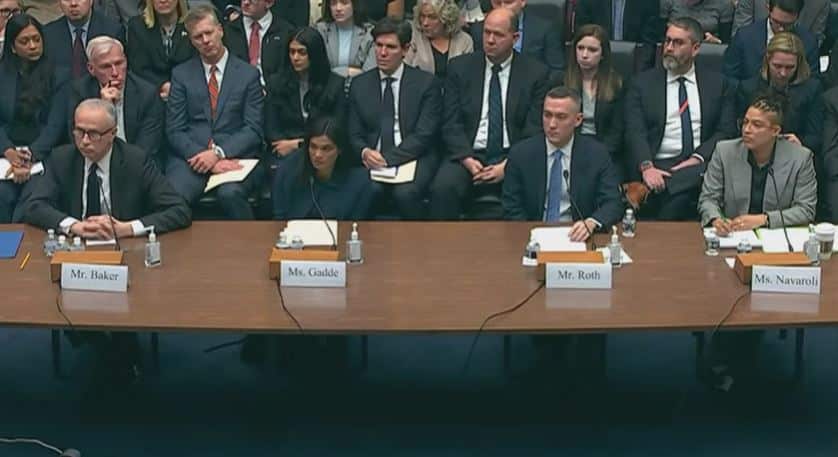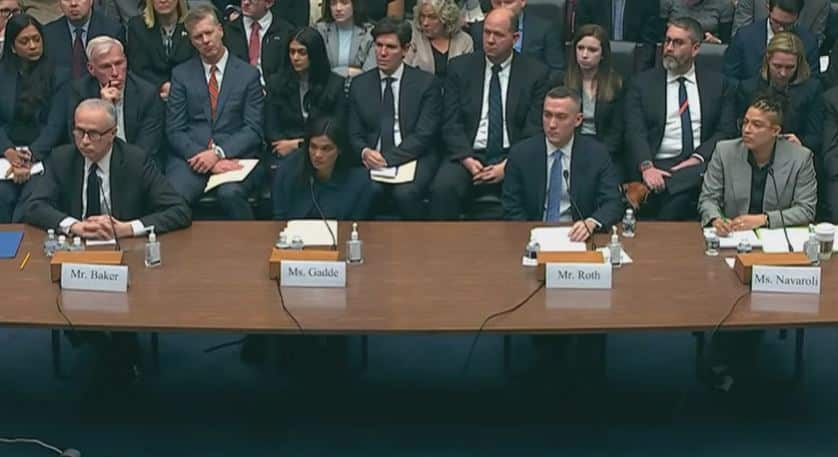Yesterday’s hearing of the House Oversight Committee featured three former Twitter executives who are at the center of the growing censorship scandal involving the company: Twitter’s former chief legal officer Vijaya Gadde, former deputy general counsel James Baker and former head of trust and safety Yoel Roth. However, it was the testimony of the only witness called by the Democrats that proved the most enlightening and chilling. Former Twitter executive Anika Collier Navaroli testified on what she repeatedly called the “nuanced” standard used by her and her staff on censorship.
Toward the end of the hearing, she was asked about that standard by Rep. Melanie Ann Stansbury (D., NM). Her answer captured precisely why Twitter’s censorship system proved a nightmare for free expression. Stansbury’s agreement with her take on censorship only magnified the concerns over the protection of free speech on social media.
Even before Stansbury’s question, the hearing had troubling moments. Ranking Member Rep. Jamie Raskin (D., Md) opened up the hearing insisting that Twitter has not censored enough material and suggesting that it was still fueling violence by allowing disinformation to be posted on the platform.
Navaroli then testified how she felt that there should have been much more censorship and how she fought with the company to remove more material that she and her staff considered “dog whistles” and “coded” messaging.
Rep. Stansbury asked what Twitter has done and is doing to combat hate speech on its platform. Navaroli correctly declined to address current policies since she has not been at the company for some time. However, she then said that they balanced free speech against safety and explained that they sought a different approach:
Instead of asking just free speech versus safety to say free speech for whom and public safety for whom. So whose free expression are we protecting at the expense of whose safety and whose safety are we willing to allow to go the winds so that people can speak freely.
Rep. Stansbury responded by saying “Exactly.”
The statement was reminiscent to the statement of the former CEO Parag Agrawal. After taking over as CEO, Agrawal pledged to regulate content as “reflective of things that we believe lead to a healthier public conversation.” Agrawal said the company would “focus less on thinking about free speech” because “speech is easy on the internet. Most people can speak. Where our role is particularly emphasized is who can be heard.”
Navaroli was saying that it is not enough to simply balance free speech against public safety (a standard that most free speech advocates would oppose as ill-defined and fluid). Instead, Navaroli and her staff would decide “free speech for whom and public safety for whom.”
The suggestion is that free speech protections would differ with the speakers or who was deemed at risk from the exercise of free speech. It takes a subjective balancing test and makes it even more ambiguous and illusory. Free speech demands bright lines to avoid the chilling effect of uncertainty for citizens. The Twitter standard described by Navaroli defies definition, let alone understanding, for anyone posting controversial or dissenting views.
In the hearing, the Democratic members and witnesses repeatedly returned to the statement of Holmes on “shouting fire in a crowded theater.” The hearing shows how this statement has been grossly misused as a justification for censorship. From statements on the pandemic to climate change, anti-free speech advocates are claiming that opponents are screaming “fire” and causing panic.
The line comes from Schenck v. United States, a case that discarded the free speech rights of citizens opposing the draft. Charles Schenck and Elizabeth Baer were leading socialists in Philadelphia who opposed the draft in World War I. Fliers were distributed that encouraged men to “assert your rights” and stand up for their right to refuse such conscription as a form of involuntary servitude. Writing for the Court, Justice Oliver Wendell Holmes dismissed the free speech interests in protecting the war and the draft.
He then wrote the most regrettable and misunderstood judicial soundbites in history: “the character of every act depends on the circumstances in which it is done . . . The most stringent protection of free speech would not protect a man in falsely shouting fire in a theater and causing a panic.” “Shouting fire in a crowded theater” quickly became a mantra for every effort to curtail free speech.
Holmes sought to narrow his clear and present danger test in his dissent in Abrams v. United States. He warned that “we should be eternally vigilant against attempts to check the expression of opinions that we loath and believe to be frought (sic) with death, unless they so imminently threaten immediate interference with the lawful and pressing purposes of the law that at an immediate check is required to save the country.”
Holmes’ reframing of his view would foreshadow the standard in Brandenburg v. Ohio, where the Supreme Court ruled that even calling for violence is protected under the First Amendment unless there is a threat of “imminent lawless action and is likely to incite or produce such action.”
However, Navaroli, Stansbury, and others are still channeling the standard from Schenck, which is a curious choice for most Democrats in using a standard used against socialists and anti-war protesters.
Yet, Navaroli’s standard from Twitter makes the Schenck standard look like the model of clarity. Essentially, she adds that you also have to consider the theater, movie, and audience to decide what speech to allow. What could be treated as crying “Fire!” by any given person or in any given circumstances would change according to their “nuanced” judgment.
According to Navaroli, she and her staff would not allow the “safety [of others] to go the winds so that people can speak freely.” It is the classic defense of censorship in history and the touchstone of every authoritarian regime today. Today’s hearing will address the question of when corporate censorship programs become an extension of the government. However, while it is unclear how Twitter’s censorship made us more safe, Twitter’s “nuanced” standard certainly allowed free speech to “go to the winds” of censorship.
You can find the Stansbury-Navaroli exchange around the 5:00 mark below:
Reprinted with permission from JonathanTurley.org.


